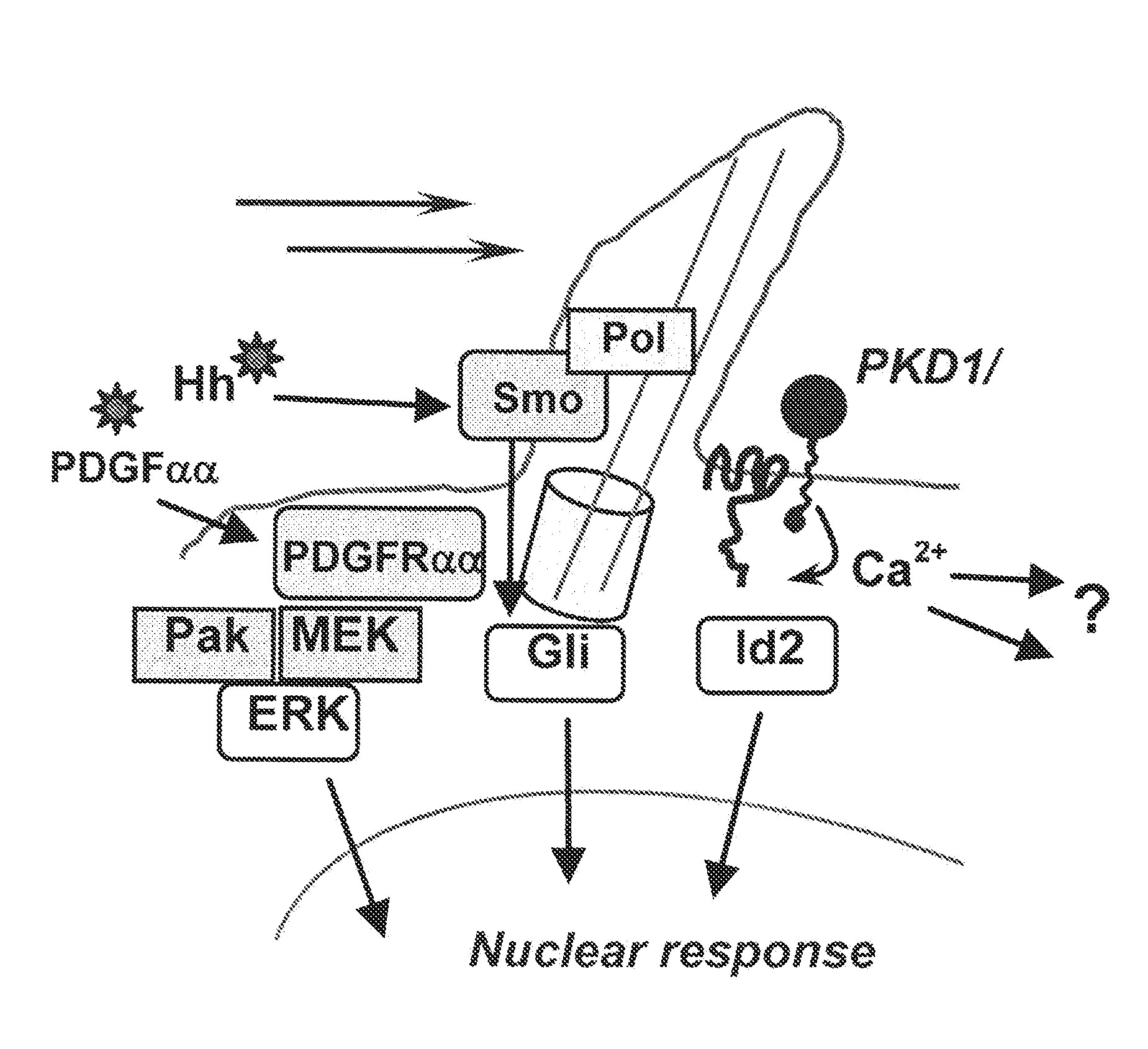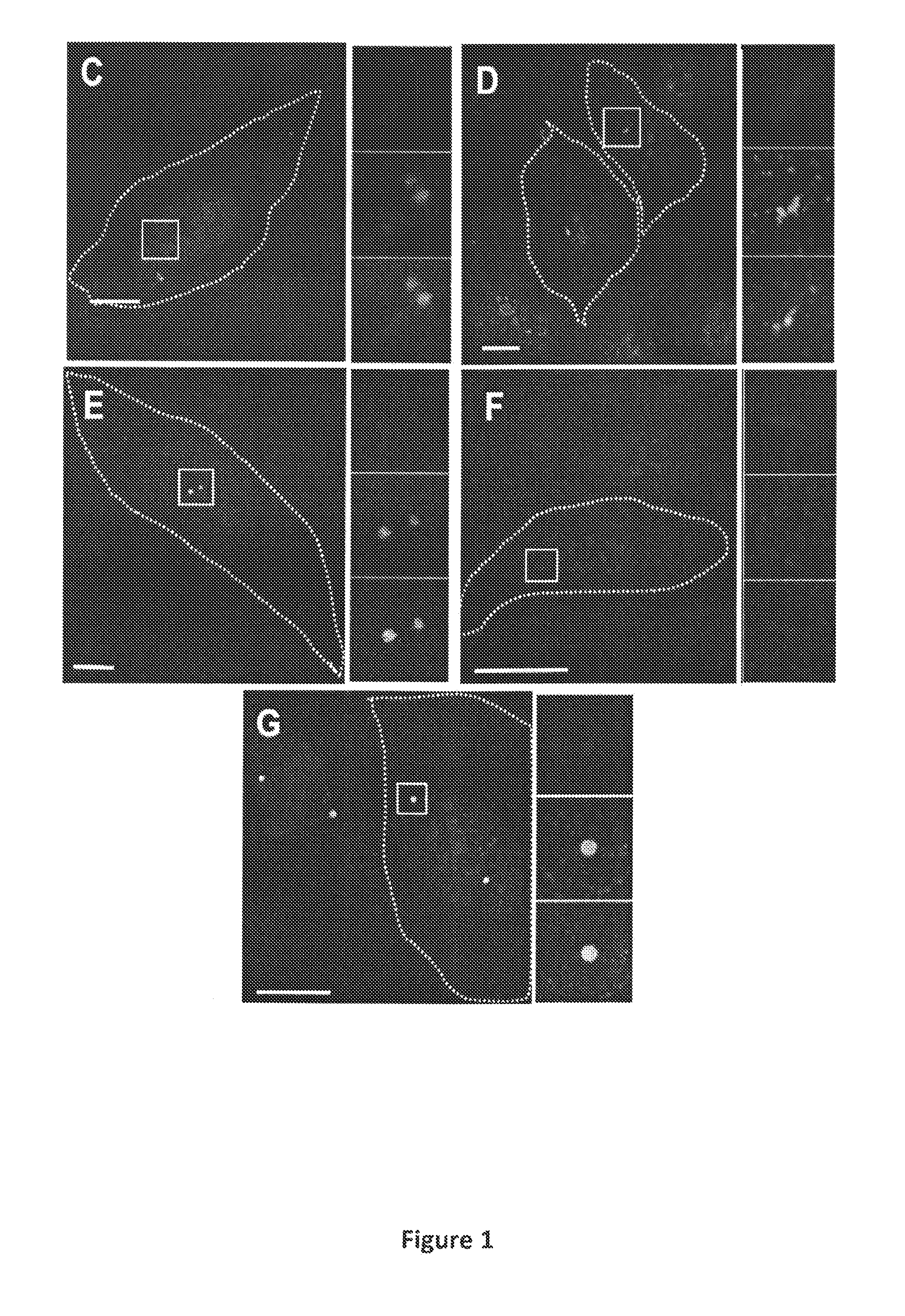Compositions and Methods for the Treatment of Diseases Associated with Aberrant Cilia Assembly and Regulation
a technology of aberrant cilia and cilia, applied in the field of molecular biology and ciliaassociated structural and cellular signal transduction, can solve the problems of cancer promotion by defective ciliary signaling
- Summary
- Abstract
- Description
- Claims
- Application Information
AI Technical Summary
Benefits of technology
Problems solved by technology
Method used
Image
Examples
example i
[0054]We demonstrate that an association between AurA and HEF1 at cilia in response to extracellular cues is required for ciliary disassembly. We also show that AurA activation is independently sufficient to induce rapid ciliary resorption, and that AurA acts in this process through phosphorylating HDAC6, thus stimulating HDAC6-dependent tubulin deacetylation (Hubbert et al., 2002) and destabilizing the ciliary axoneme. Importantly, our identification of a spatiotemporally restricted action of AurA at the ciliary basal body in cells emerging from G0 demonstrates an unexpected non-mitotic activity for AurA in vertebrate cells. We also determine that small molecule inhibitors of AurA and HDAC6 reduce regulated disassembly of cilia, which may have important implications for the action of these drugs in the clinic. Together, these data reveal important activities for HEF1, AurA, and HDAC6 in regulation of ciliary resorption, which should also inform the actions of these proteins in cell...
example 2
Generation of a Mouse Model to Study PKD
[0071]At present, there are numerous competing models to explain the basis for cyst formation, and the differences between the various syndromes associated with kidney cysts. Studies of the signaling changes that occur in PKD have identified anomalous function of pathways that affect proliferation, cell cycle, and apoptosis (Edelstein, C. L. (2005) Cell Cycle 4:1550-4). Downstream elements of these signaling pathways include the tumor suppressors PTEN, TSC2, and p53, the oncogenes Bcl-2 and Akt, and other important growth regulators such as mTOR (Shillingford, J. M. et al. (2006) PNAS 103: 5466-71). Current therapeutic strategies are attempting to exploit this information by using drugs that target the relevant processes and pathways, such as the use of caspase inhibitors to reduce apoptosis, and mTOR inhibitors to block cell proliferation (Tao Y., et al. (2005) PNAS 102: 6954-9). In some cases, these approaches are alleviating symptoms and sl...
example 3
REFERENCES FOR EXAMPLE 3
[0153]Anand, S., Penrhyn-Lowe, S., and Venkitaraman, A. R. (2003). AURORA-A amplification overrides the mitotic spindle assembly checkpoint, inducing resistance to Taxol. Cancer Cell 3, 51-62.[0154]Andrews, P. D. (2005). Aurora kinases: shining lights on the therapeutic horizon? Oncogene 24, 5005-5015.[0155]Anyatonwu, G. I., Estrada, M., Tian, X., Somlo, S., and Ehrlich, B. E. (2007). Regulation of ryanodine receptor-dependent calcium signaling by polycystin-2. Proc Natl Acad Sci USA 104, 6454-6459.[0156]Battini, L., Macip, S., Fedorova, E., Dikman, S., Somlo, S., Montagna, C., and Gusella, G. L. (2008). Loss of polycystin-1 causes centrosome amplification and genomic instability. Hum Mol Genet. 17, 2819-2833.[0157]Benzing, T., and Walz, G. (2006). Cilium-generated signaling: a cellular GPS? Curr Opin Nephrol Hypertens 15, 245-249.[0158]Bischoff, J. R., Anderson, L., Zhu, Y., Mossie, K., Ng, L., Souza, B., Schryver, B., Flanagan, P., Clairvoyant, F., Ginther,...
PUM
| Property | Measurement | Unit |
|---|---|---|
| time | aaaaa | aaaaa |
| time | aaaaa | aaaaa |
| length | aaaaa | aaaaa |
Abstract
Description
Claims
Application Information
 Login to View More
Login to View More - R&D
- Intellectual Property
- Life Sciences
- Materials
- Tech Scout
- Unparalleled Data Quality
- Higher Quality Content
- 60% Fewer Hallucinations
Browse by: Latest US Patents, China's latest patents, Technical Efficacy Thesaurus, Application Domain, Technology Topic, Popular Technical Reports.
© 2025 PatSnap. All rights reserved.Legal|Privacy policy|Modern Slavery Act Transparency Statement|Sitemap|About US| Contact US: help@patsnap.com



